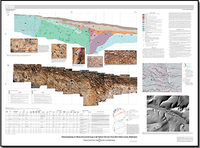The Boylston Mountains anticlinal ridge is one of several that are cored by rocks of the Columbia River Basalt Group and, with the interceding synclinal valleys, constitute the Yakima fold-and-thrust belt of central Washington. Lidar data acquired from the U.S. Army's Yakima Training Center reveal a prominent, northwest-side-up, 65°- to 70°-trending, 3- to 4-meter-high scarp that cuts across the western end of the Boylston Mountains, perpendicular to the mapped anticline. The scarp continues to the northeast from the ridge on the southern side of Park Creek and across the low ridges for a total length of about 3 kilometers. A small stream deeply incises its flood plain where it projects across Johnson Canyon. The scarp is inferred to be late Quaternary in age based on its presence on the modern landscape and the incised flood-plain sediments in Johnson Canyon. Two trenches were excavated across this scarp. The most informative of the two, the Horned Lizard trench, exposed shallow, 15.5-Ma Grande Ronde Basalt, which is split by a deep, wide crack that is coincident with the base of the scarp and filled with wedges of silty gravels that are interpreted to represent at least two generations of fault colluvium that offset a buried soil.


